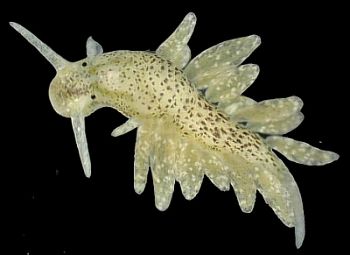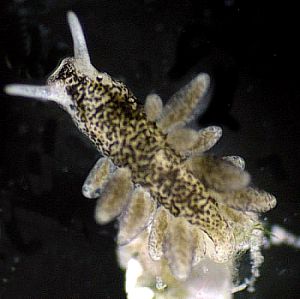

Ercolania fuscata
(Gould, 1870)
Order: SACOGLOSSA
Superfamily: LIMAPONTIOIDEA
Family: Limapontiidae
DISTRIBUTION
East Coast of Nth America
PHOTO
From mat of Cladophora liniformis. South of Sarasota, Florida (west coast), USA. Upper: 6mm long, lower; 3mm. PHOTOS: Anna Bass.
Grows to about 8mm, and more typically has a transverse pattern of dark green to black pigmentation arranged in irregular bands across the back. The cerata start about one-third of the way down the body. Bleakney, 1996 describes how in Canada, this species feeds on the filamentous algae Cladophora and Chaetomorpha. Although the algae are essentially single filaments they usually are intertwined and tangled with adjacent filaments to form tangled colonies. Ercolania feeds by piercing a cell wall and sucking out the cell contents. The empty cells become weak points in the algal filament which can break under wave action. When many E fuscata congregate and feed at the base of these algal colonies they can cause whole algal mats to break loose. Bleakney describes how by late summer large numbers of these algal mats have broken loose and are drifting around in bays up and down the coast, with Ercolania 'aboard'.
References:
• Gould, A.A. (1870). Report on the Invertebrata of Massachusetts. Second edition, comprising the mollusca. Edited by W.G. Binney. Boston, v(3) plus 524 pp., text figs. 350-754, coloured pls. 16-27 comprising figs. 214-349
• Marcus, E. (1957) On Opisthobranchia from Brazil (2). Journal of the Linnean Society, Zoology, 43: 390-486.
• Jensen, K. & Clark, K.B. (1983) Annotated checklist of Florida ascoglossan opisthobranchs.
The Nautilus, 97: 1-13.
Rudman, W.B., 2001 (April 18) Ercolania fuscata (Gould, 1870). [In] Sea Slug Forum. Australian Museum, Sydney. Available from http://www.seaslugforum.net/find/ercofusc
Related messages
Re: Colour variation in Ercolania fuscata
April 26, 2001
From: Anna L. Bass
Hey,
When I first found these animals, I took them out and placed them in a smaller watch glass to examine them under a dissecting microscope. They proceeded to copulate fervently! Upon finding the larger and greener animal, I again removed the two color forms and placed them in a watch glass to facilitate photographing them. Once again they immediately starting copulating. I had hoped to get a photo of this steamy action, but couldn't get them in focus. I haven't noticed any egg masses, though, so Kathe's point regarding viability and fertility of offspring is still unanswered. I'll keep looking though. Bill, I have moved them all into the aerated tank, but haven't had a chance to look for the browner morphs. Your point is well taken and I would hesitate to call these separate species.
Regards from Florida,
Anna
abass@helios.acomp.usf.edu
Bass, A.L., 2001 (Apr 26) Re: Colour variation in Ercolania fuscata. [Message in] Sea Slug Forum. Australian Museum, Sydney. Available from http://www.seaslugforum.net/find/4238Thanks Anna,
Isn't great studying live animals? I look forward to progress reports
Bill Rudman
Colour variation in Ercolania fuscata
April 24, 2001
From: Kathe Jensen
Dear Bill and Anna,
Anna's pictures of Ercolania fuscata from Florida is a perfect illustration of why Kerry Clark and I many years ago decided to synonymize E. fuscata and E. vanellus (then Stiliger vanellus). The pale form fits Marcus's description of E. vanellus, and the dark form is what has always been called E. fuscata (or Stiliger fuscatus) in NE America. We had an idea that the pale form was more of a warm water form, but when we started finding mixed populations that idea was dropped. My suggestion would be to place a pale and a dark specimen together and see what happens - I can almost guarantee mating and subsequent spawning, which is a pretty good indication of conspecificity (although we cannot say for sure if the offspring
will be fertile).
References:
• Marcus, E. (1957) On Opisthobranchia from Brazil (2). Journal of the Linnean Society, Zoology, 43: 390-486.
• Jensen, K. & Clark, K.B. (1983) Annotated checklist of Florida ascoglossan opisthobranchs. The Nautilus, 97: 1-13.
Greetings,
Kathe
jensen@ait.ac.th
Jensen, K., 2001 (Apr 24) Colour variation in Ercolania fuscata. [Message in] Sea Slug Forum. Australian Museum, Sydney. Available from http://www.seaslugforum.net/find/4233Thanks Kathe,
It's great to have these colour photos. It certainly makes it so much easier to visualise colour variations and similarities when you can look at photos rather than just words on a printed page.
Best wishes,
Bill Rudman
Re: Ercolania fuscata from Florida
April 23, 2001
From: Anna L. Bass
Hi Dr. Rudman,
Thank you for correcting my id. I'm still learning how to figure out who is who. I agree that a few specimens doesn't tell you a lot. I did want to clarify that my observation was based on a total of 20 animals. 16 individuals were found in the non-aerated tank and had the brown appearance while 4 other individuals were found in the aerated tank and were larger and had the green color similar to the first photo. I didn't actually take measurements on all specimens so can't say that there were any statistically significant differences. Just an observation.
Best Regards,
Anna L. Bass
abass@helios.acomp.usf.edu
Bass, A.L., 2001 (Apr 23) Re: Ercolania fuscata from Florida. [Message in] Sea Slug Forum. Australian Museum, Sydney. Available from http://www.seaslugforum.net/find/4226Thanks Anna,
Perhaps you should put a few of the dark ones in the aerated tank and see if they 'green' up a bit. I hesitate to suggest two species but I guess anything is possible. Sometimes we find two very similar looking species together. They may be separable on anatomical differences, but sometimes the only easy way to distinguish them is their food or some aspect of their life history.
Bill Rudman
Ercolania fuscata from Florida
April 19, 2001
From: Anna Bass


Hi Dr. Rudman,
Just wanted to send you these images of what I believe is Stiliger fuscatus. These apparently were collected as eggs in a Cladophora liniformis mat. I was walking the shore south of Sarasota, on the west coast of Florida, USA and there was quite a bit of wave action. I couldn't get into the water so just grabbed some of algae and brought it back to the lab.
Both of these animals come from the same clump of algae although I do not know if they are from the same egg mass. The only diffence was that the darker one (lower photo) was kept in a smaller non-filtered container and the other (upper photo) was in a filtered aquarium. Both were aerated. I thought this might be a good example of how different animals can look depending upon the quality of their food and other environmental conditions. I cannot negate the possibility that these may be reflect different "age" classes.
Best Regards,
Anna
abass@helios.acomp.usf.edu
Bass, A., 2001 (Apr 19) Ercolania fuscata from Florida. [Message in] Sea Slug Forum. Australian Museum, Sydney. Available from http://www.seaslugforum.net/find/4194Dear Anna,
Thanks for the photos. I'm afraid with two animals it's a bit difficult to know whether differences are just normal genetic variation or the result of some environmental effect.
My understanding is that this species is more appropriately placed in the genus Ercolania on the basis of its radular morphology, simple rhinophores and other anatomical characters
Best wishes,
Bill Rudman
